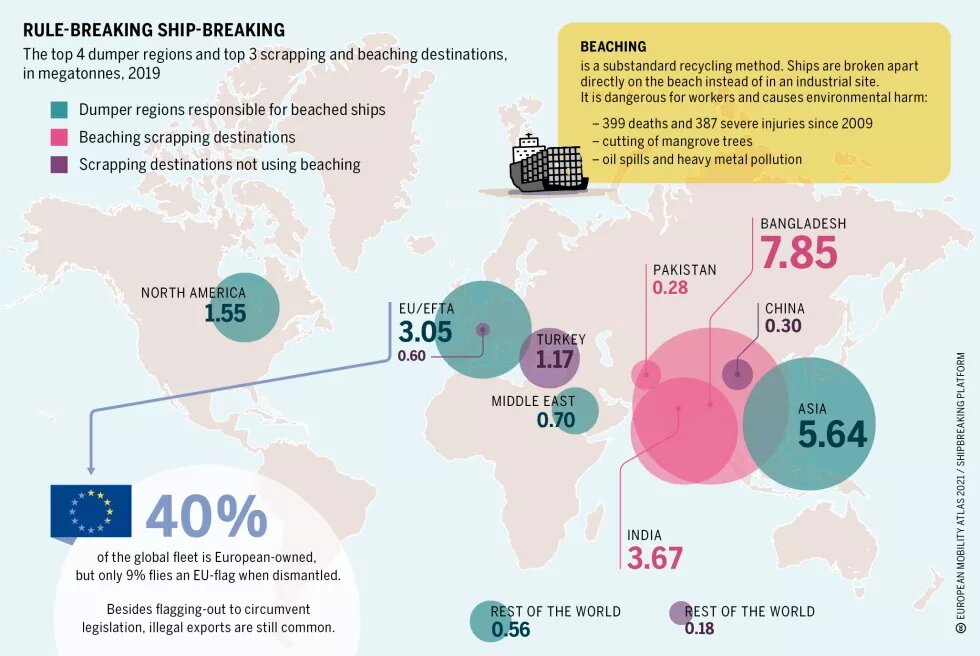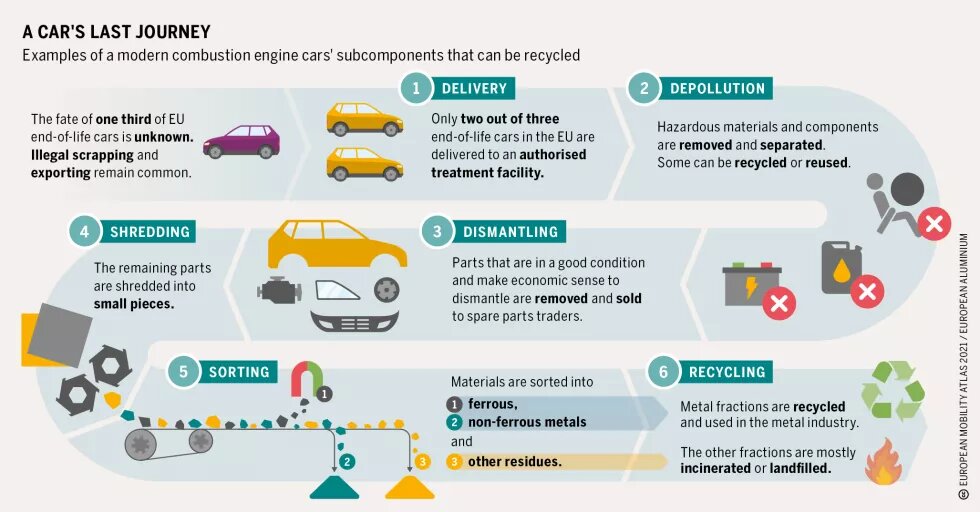
Increasing mobility and trade as well as the shortening of a vehicle's average life have led to a growing number of vehicles that have reached the end of their useful life in Europe.

Managing this waste is a technical and economic challenge and illegal scrapping and dumping are still common, with significant impacts on the environment and public health.
Economic growth and globalisation have dramatically increased the number of trains, planes, ships and cars worldwide. It is therefore becoming increasingly crucial to find economically and ecologically sound ways to treat vehicles that have reached the end of their life. They contain valuable parts and materials that can be reused or recycled, but also hazardous substances that can cause environmental and human health concerns.
Trains and planes are massive vehicles whose waste management is a technological challenge. As they need very specific infrastructure to function and generally last for a long time, they have not been the number one priority concern when it comes to safe and efficient recycling and waste disposal. The situation for cars and ships is more problematic.
Every year, around 12 million cars leave European roads due to total loss after an accident, economic write-off, non-compliance with new safety or emissions standards or a change in design preferences. Around half of them are handled in authorised recycling facilities. EU legislation puts responsibility for managing the end-of-life of a car on the actors that place them on the market and requires clunkers to be stripped of all hazardous substances by authorised dismantlers in safe surroundings and 85 percent of the car's weight to be reused or recycled. Traditionally, the high value of metals and reusable pieces ensured a high recovery rate. Price fluctuations of metals and the changing composition of vehicles is a challenge for scrappers. Plastics and nanomaterials, for instance, have improved fuel efficiency, but are not recyclable and are incinerated or landfilled. Finding safe ways to handle a growing amount of electric cars is also imperative, as rare earths and batteries are associated with environmental and human problems.
There are about four million cars of ‘unknown whereabouts’ annually, meaning they are deregistered without information available indicating that the vehicle has been handled in an authorised recycling facility or has been exported. The bulk of the missing cars get lost in Europe’s still flourishing market of illegal dismantling. Not following the EU's safety and environmental rules, it distorts fair business practices by compliant scrappers and has a significant environmental impact as up to 55 million of litres of hazardous liquids, such as oil and air conditioner fluid, go unaccounted for every year. Some of the cars of unknown whereabouts are also exported to third countries. As end-of-life vehicles are considered hazardous waste, their export from the EU to non-OECD countries is forbidden. In practice, however, it is difficult to distinguish between a used vehicle whose export is legal and an end-of-life car. Even though the trade in these vehicles can create economic opportunities, uncontrolled substandard scrapping and the continued use of high emission vehicles in ever-growing cities pose environmental and health risks to local ecosystems and communities.
Just like cars, ships too become waste when they reach the end of their service. Up until the 1970s, commercial vessels were dismantled mainly in Europe and the United States, but as social and environmental protection laws became stricter, the industry shifted to areas where legal frameworks are weaker. In 2019, almost 90 percent of the world’s end-of-life tonnage was broken up in India, Bangladesh and Pakistan without proper infrastructure, equipment and procedures to prevent accidents and pollution. The ship-breaking method used is called ‘beaching’ and entails the ships’ grounding on an intertidal mudflat at high tide. As ships contain numerous toxic materials, such as asbestos, oil residues, heavy metals and toxic paints, this pollutes coastal and maritime ecosystems. Local communities that depend on them suffer. Furthermore, ship-breaking has been declared the most dangerous job in the world by the International Labour Organisation. Fires, handling hazardous waste, inhaling toxic fumes and falling steel plates can injure or even kill workers. Ship-breakers include many migrants and teenagers.
Cleaner and safer methods of ship recycling are available. European shipping companies control around 40 percent of the world fleet and are therefore crucial in finding sustainable solutions. To stop these companies from using the low-cost and substandard method of beaching, the EU has passed legislation that requires vessels registered under the flag of an EU Member State to be recycled at a facility included on an official list of facilities that operate in line with the standards for ship recycling set by the EU. However, over two thirds of ships of European owners continue to be beached because older vessels are often either sold or re-flagged to avoid regulation.
When speaking about end-of-life vehicles, it is important to recall that the most easily manageable waste is waste that is not generated in the first place. Mobility as a service with less individual ownership and more sharing concepts as well as reducing transport whenever possible are therefore priority actions to take. Eco-designing vehicles, including their longevity, repairability and recyclability, enforcement and improvement of existing laws as well as research into better recycling technologies can also help to reduce waste from end-of-life vehicles.
Sources for data and graphics: European Aluminium, https://bit.ly/35Z1WCc; NGO Shipbreaking Platform, annual lists of scrapped ships, https://bit.ly/31UoIsu

